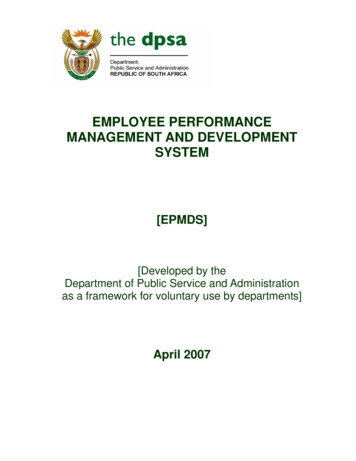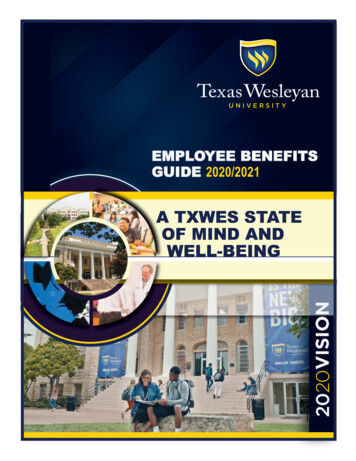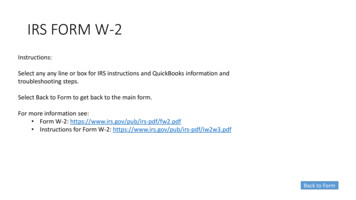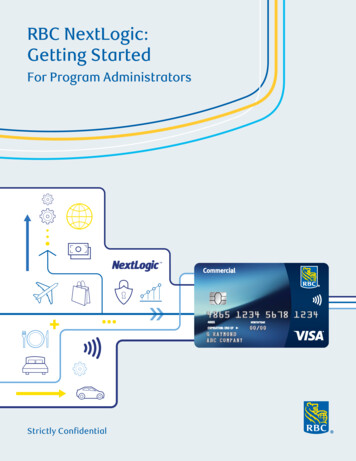
Transcription
EMPLOYEE PERFORMANCEMANAGEMENT AND DEVELOPMENTSYSTEM[EPMDS][Developed by theDepartment of Public Service and Administrationas a framework for voluntary use by departments]April 2007
EMPLOYEE PERFORMANCE MANAGEMENT AND DEVELOPMENTSYSTEM (EPMDS)PAGETABLE OF CONTENTSAcronyms4Glossary of terms51.0INTRODUCTION82.0SCOPE AND APPLICATION93.0SOURCES OF AUTHORITY94.0AIMS OF PERFORMANCE E PERFORMANCE CYCLE116.0PERFORMANCE PLANNING AND AGREEMENT116.1The performance agreement6.2The workplan126.3The personal development plan136.4Prolonged absence and staff movement136.5Amendments to the performance agreement157.0PERFORMANCE MONITORING, REVIEW AND ASSESSMENT157.1Performance monitoring157.2Categories of performance157.3Five point rating scale167.4Performance review and assessment167.5Annual performance assessment178.0PERFORMANCE MODERATION198.1Normal distribution curve of performance categories20EPMDS April 200710101024/04/07112
PAGETABLE OF CONTENTS8.2The intermediate review committee218.3Departmental Moderating Committee218.4Assessment Appeal Panel228.5Disagreements over rating and assessments239.0OUTCOMES OF PERFORMANCE ASSESSMENT239.1Probation239.2Managing performance that is not fully effective249.3Pay progression249.4Departmental performance incentive scheme259.5Performance bonus269.6Budget for incentives289.7Non-financial incentives10.0SYSTEM EVALUATION AND REVIEW11.0INSTITUTIONAL FRAMEWORK282930ANNEXURES.Annexure ATemplate for the performance agreementAnnexure BGuide to the performance workplanAnnexure CGuide to generic assessment factorsAnnexure DIllustrative format for Personal Development PlanAnnexure EHalf-yearly review formAnnexure FPerformance assessment instrumentAnnexure GProbation assessment formAnnexure HProcedures for non-agreements on assessmentEPMDS April 200724/04/073
MSMPSAMTEFPAPARPDPPFMAPMDSPSAPSCPSCBCPSRSMSSMS PMDSVAREPMDS April 2007Assessment Appeal PanelConfirmed assessment rating (by DMC)Core management criteriaDirector-GeneralDepartmental Moderating CommitteeDepartment of Public Service and AdministrationExecutive AuthorityGeneric assessment factorHead of DepartmentHuman resource developmentHuman resource managementIntermediate Review CommitteeKey result areaMember of the Executive CouncilMiddle Management Service (as from 1 July 2005)Minister for the Public Service and AdministrationMedium Term Expenditure FrameworkPerformance agreementProvisional assessment ratingPersonal development planPublic Finance Management Act, 1999Performance Management and Development SystemPublic Service Act, 1994Public Service CommissionPublic Service Co-ordinating Bargaining CouncilPublic Service Regulations, 2001Senior Management ServicePerformance Management and Development System for the SMSValidated assessment rating (by CDAP)24/04/074
GLOSSARY OF TERMSAnnual performance rating: The annual performance rating as part of an employee’sassessment that takes place at the end of the performance cycle. The result of this rating is theoverall annual performance score for the employee during the entire performance cycle.Assessment instrument: An assessment tool used to assess the performance of an individualemployee in relation to the achievement of key result areas and core management criteria orgeneric assessment factors as contained in the workplan of the performance agreement.Attribute: An attribute (as part of a competency) is generally defined to consist of motives, traitsand self-concept.Competence: Relates to an employee’s capacity to meet the job requirements (jobcompetence).Competency: A competency is a particular mix of knowledge, skills and attributes required toeffectively perform a job/task/role.Confirmed assessment rating: The assessment score for an employee that has beenconfirmed by the departmental Moderating Committee (see also validated and provisionalassessment rating).Core Management Criteria (CMC): An element of knowledge, skill, or attribute in the SMSPMDS that is directly related to effective performance in a job, applicable to SMS members.Customers: People internal or external to the department with whom employees interact toprovide a service.Department: A department as defined in section 1 of the Public Service Act, 1994.Development: Training and development activities to enhance the employee's competenciesand to improve performance.Executive Authority: In relation to a department, government agency or institution, thePresident, a Minister, Premier or Member of the Executive Council.Feedback: Objective and timely information by the Director/supervisor on the employee'sperformance against set expectations and standards, understood by the staff member, andaimed at improving performance.Generic Assessment Factor: An element used to describe and assess aspects ofperformance, taking into consideration knowledge, skills and attributes.Grievance rules: The rules for dealing with the grievances of employees in the Public Service,published by the Public Service Commission in Government Notice R 1012 of 25 July 2003,Government Gazette No. 25209.Incentive Policy Framework: Salary Level 1 to 12: DPSA circular 1/7/1/4/1, dated 27 January2003: “Implementation of an incentive policy framework linked to departmental performancemanagement systems for employees on salary levels 1 to 12.”EPMDS April 200724/04/075
Integrated Performance Management and Development System (IPMDS): A performancemanagement system developed by the DPSA in 2003 for voluntary use in the Public Service.Key Result Area (KRA): An area of a job in which performance is critical for making aneffective contribution to the achievement of departmental strategies, goals and objectivesModeration: The review of employee assessment scores by a committee to ensure consistencyand fairness across the department through a common understanding of performancestandards required at each level of the rating scale and to assist in complying with therequirement that expenditure on bonuses should not exceed 1.5% of the remuneration budgetOperational plan(s) (or business plan): A one-year plan derived from and giving life to thestrategic plan by translating the strategic objectives identified in the strategic plan into key resultareas and activities with measurable standards, for a particular year for the Department,Branches, Chief Directorates and Directorates.Outcome: A broad statement about a specific objective, aim or intent, the achievement of whichwill require one or more specific outputs to be achieved.Output: A concrete result or achievement (i.e. a product, action or service) that contributes tothe achievement of a key result area.Performance: Human performance involves (1) employee actions, and (2) the outcomes oreffects of those actions. Performance is a process in which resources are used in an effective,efficient and productive way to produce results that satisfy requirements of time, quality andquantity, and which are the effect or outcome of the actions or behaviour of a performer in thework process.Performance agreement: A document agreed upon and signed by an employee and her or hissupervisor, which includes a description of the job, selected KRAs and GAFs, a workplan andthe employee’s personal development plan.Performance appraisal/assessment: The measurement, assessment, rating or appraisal ofemployee performance. The formal annual process is usually referred to as performanceappraisal or assessment, while more informal processes are referred to as performance review.Performance cycle: A 12-month period for which performance is planned, managed andassessed. It must be aligned to the same period as the Department’s annual business plan i.e.1st April to 31st March of the following year.Performance incentives: A set of (a) financial rewards linked to the results of performanceappraisal, including pay progression, performance bonus, and (b) a variety of non-financialrewards that may be contained in the departmental performance incentive scheme.Performance incentive scheme: A departmental performance related incentive schemealigned with its performance management system, established in terms of PSR 1/VIII F and G.Performance indicator: A measure used to gauge the extent to which an output has beenachieved (policy developed, presentation delivered, service rendered).Performance management: A purposeful, continuous process aimed at managing anddeveloping employee behaviour for the achievement of the organisation’s strategic goals; thedetermination of the correct activities as well as the evaluation and recognition of the executionof tasks/duties with the aim of enhancing their efficiency and effectiveness; and a means ofimproving results from the Department, teams and individuals by managing performance withinan agreed framework of planned goals, objectives, standards and incentives.EPMDS April 200724/04/076
Performance management system: An authoritative framework for managing employeeperformance, which includes the policy framework as well as the framework relating to allaspects and elements in the performance cycle, including performance planning andagreement; performance monitoring, review and control; performance appraisal andmoderating; and managing the outcomes of appraisal.Performance standard: Mutually agreed criteria to describe work in terms of time-lines, costand quantity and/or quality to clarify the outputs and related activities of a job by describing whatthe required result should be. In this framework, performance standards are divided intoindicators and the time factor.Performance review: A structured and formal, at least half-yearly, discussion betweensupervisor and employee to monitor progress, resolve problems and adjust work plans duringthe performance cycle, thereby providing an opportunity for improvement before the annualreview takes place. If the employee's performance is not fully effective or unsatisfactory, thehalf-yearly review must be in writing.Personal development plan (PDP): A requirement of the performance agreement whereby theimportant competency and other developmental needs of the employee are documented,together with the means by which these needs are to be satisfied and which includes time linesand accountabilities.Provisional assessment rating (PAR): An employee’s total assessment rating score that hasbeen agreed upon between the employee and her/his supervisor.Rating: The allocation of a score to a KRA, a GAF and/or to overall performance in accordancewith the five-point rating scale of the PMDS.Senior Management Service (SMS): Employees on salary levels 13 to 16, including managersand professionals.Strategic plan: The end product of strategic planning, setting out the mission and visionstatements and the medium and long-term strategic objectives of the Department. The contentsof the strategic plan must be in compliance with the requirements of Chapter 5 of the TreasuryRegulations, 2001, and Chapter 1 Part III.B of the Public Service Regulations, 2001.Strategic planning: The process by which top management determines the overall strategicdirection and priorities, as well as the organisational purpose and objectives and how they areto be achieved.Supervisor: An official responsible for the allocation of work, monitoring of activities,discussing performance and development, and the half-yearly performance review and annualperformance rating of an employee.Validated assessment rating (VAR): The performance rating for an employee that has beenvalidated by an assessment higher than the employee’s supervisor for submission to theDepartmental Moderating Committee.Weight: With reference to the inclusion and assessment of KRAs and GAFs in the performanceagreement/workplan, each KRA and GAF is allocated a weight or percentage, which indicatesthe relative importance or impact of the specific KRA or GAF in comparison to the othersselected in the performance agreement, and the combined weights must add up to 100%.Workplan: A document which is part of the performance agreement and which contains keyresult areas, associated outputs/activities and their performance standards and resourcerequirements.EPMDS April 200724/04/077
EMPLOYEE PERFORMANCE MANAGEMENT AND DEVELOPMENTSYSTEM (EPMDS)1INTRODUCTIONThe Employee Performance Management and Development System (EPMDS)1 hasbeen designed as a voluntary system to assist with performance management on salarylevels 1 to 12 in departments and provinces that may choose to adopt the system. Thisamended system becomes effective on 1 April 2007.Key role-players in the performance management process are identified. Should these“roles” not be present in a department or if they have other titles, the applicable roleand/or title should be substituted. The term “component” is used as a generic title forany sub-division of a department. The substitution of own department sub-division titlesmay be required. Where the statement “the Department of (ABC)” appears in the text, orannexures the name of the specific department must be substituted.The EPMDS provides a standardised framework for employee performance on salarylevels 1 to 12 in a department. Three main levels are involved in performancemanagement: At the organisational level the Executive Authority and the HoD determinethe strategic priorities and overall key result areas of the department, while objectivesare identified for the priorities and assigned to components within the department. At thecomponent level components undertake the execution of projects and activities thatlead to the achievement of the integrated business plans. At the employee level eachemployee develops a performance agreement jointly with her or his supervisor.Key requirements for the successful implementation of the EPMDS are the following:The institutional framework determines responsibilities for specific aspects of theEPMDS. With the Strategic Plan as basis, the department is able to identify high-levelpriorities and specific objectives to be achieved by business units. However, all the workdone in a department is not captured in a strategic plan, which means that performanceagreements for employees whose key responsibility areas and activities are not coveredin the strategic or operational plan, must reflect their own KRAs and priorities.Performance Agreements enable the department to assign specific performanceobjectives and targets to employees. This also enables employees in the department toparticipate meaningfully in the management of their own performance.Another key requirement for the successful implementation of the EPMDS is training onthe system. Managers, supervisors and employees must be trained in the mechanics ofthe system and areas such as communication, problem-solving and conflict resolution inorder to manage the system more effectively. The training of supervisors in particular isof the utmost importance, and this should result in supervisors knowing how toimplement the system, ensuring that employees receive adequate training and possesssufficient information to be able to fully participate in the processes. This must be donewith the support and co-operation of the HRD unit in the Department.1This EPMDS is an amended and simplified version of the Integrated Performance Management and Development System(IPMDS) developed and distributed by the DPSA in May 2003EPMDS April 200724/04/078
2SCOPE AND APPLICATIONThe EPMDS is a framework for performance management that applies to all employeesin the Department on salary levels 1 to 12 appointed in terms of the Public Service Act,1994 (those departments/provinces that have formally adopted the EPMDS). While itshares similarities and must be linked with the SMS PMDS it is a distinct policyframework and system. As an employee performance management system, theEPMDS is not applicable to departmental, component or team performancemanagement or assessment. The date of application of this amended EPMDS is 1 April2007 for the 2007/2008 cycle.3SOURCES OF AUTHORITYThe EPMDS framework is compliant with the regulatory framework that governsperformance management at all levels in the public service, which is as follows:Performancemanagement forDepartments/Institutions/Public EntitiesHeads ofDepartmentBy means ofPerformanceauditing andstandards fororganisationaleffectiveness &efficiencyPerformanceagreements & PSCguidelines onevaluation of HODsSenior managers(SMS)Performanceagreements; andfrom 1/4/2002 theSMS PMDSAll other staff(levels 1 – 12appointed ito thePublic Service Act)Departmental PMsystem(from 1/4/2001)Statutory provisions , circularsand guidelinesPublic Finance Management Act,1999 [s. 27(4), 38(1)(b) & 40(3)(a)Treasury Regulations, 2001]Public Service Act, 1994 [s. 12(4)]Public Service Regulations, 2001,Chapter 4 Part III.Public Service Regulations, 2001,Part 1 of Annex 2, paragraph 7PSC Guidelines on HOD evaluationPSCBC Resolution 13 of 1998 &Resolution 9 of 2000Public Service Regulations, 2001,Part III of Chapter 4DPSA circular 1/2/1/P “SMSPMDS”, issued on 28/03/2002Public Service Act, 1994 subsection 3(5)(c).Public Service Regulations, 2001,Part VIII of Chapter 1.DPSA circular 1/71/4/1/ “IncentivePolicy Framework for levels 1 to 12”MonitorTreasuries & AuditorGeneralPSC plays a monitoring andadministrative/ facilitatingroleMPSA plays a monitoringand administrative/facilitating roleExecutive AuthoritySpecific sources of authority for various elements of performance management are: The Constitution of the Republic of South Africa, 1996The Public Service Act, 1994, as amendedThe Public Service Regulations, 2001 (Chapter 1, Part VIII)The Skills Development Act (Act 97 of 1998)The Labour Relations Act (Act 66 of 1995)Promotion of Equality and Prevention of Unfair Discrimination Act, (Act 4 of 2000)Promotion of Access to Information Act (Act 2 of 2000)Employment Equity Act (Act 55 of 1998)Public Finance Management Act, 1999Promotion of Administrative Justice Act, 2000EPMDS April 200724/04/079
White Paper on Transformation of the Public Service, 1995White Paper on Human Resource Management, 1997White Paper on Affirmative Action, 1998White Paper on Transforming Public Service Delivery (Batho Pele), 1997White Paper on Public Service Training and Education, 1998Treasury Regulations, 2001Relevant collective agreementsRelevant directives issued by the MPSA and, departmental policies4AIMS OF PERFORMANCE MANAGEMENT4.1GoalFor the purpose of this EPMDS, performance management is aimed at planning,managing and improving employee performance. The aim of performance managementis to optimise every employee’s output in terms of quality and quantity, therebyimproving the Department’s overall performance and service delivery.4.2ObjectivesIn order to achieve individual excellence and achievement, the objectives forperformance management are to establish a performance and learning culture in the Public Service;improve service delivery;ensure that all jobholders know and understand what is expected of them;promote interaction on performance between jobholders and their supervisors;identify, manage and promote jobholders’ development needs;evaluate performance fairly and objectively;recognise categories of performance that are fully effective and better; andmanage categories of performance that are not fully effective and lower.4.3PrinciplesThe key principles underpinning effective performance management are outlined in thePSR Chapter 1 Part VIII. These principles are the following – Departments shall manage performance in a consultative, supportive and nondiscriminatory manner to enhance organisational efficiency and effectiveness,accountability for the use of resources and the achievement of resultsPerformance management processes shall link to broad and consistent staffdevelopment plans and align with the department’s strategic goalsPerformance management processes shall be developmental, and shall allow forrecognising fully effective performance, and for an effective response toperformance that is consistently not fully effective and lowerPerformance management procedures should minimise the administrativeburden on supervisors while maintaining transparency and administrative justiceEPMDS April 200724/04/0710
5THE PERFORMANCE CYCLEPerformance management at the employee level is an on-going interactive processbetween an employee and her/his supervisor about the employee’s performance. Faceto-face on-going communication is an essential requirement of the process and coversthe full performance cycle. For effectiveness of operation the cycle is divided intointegrated phases or elements of – Performance planning and agreement;Performance monitoring, developing and control;Performance assessment or appraisal; andManaging the outcomes of assessmentThe performance cycle is a 12-month period for which performance is planned,executed and assessed. It must be aligned to the same period as the Department’sannual business plan i.e. 1st April to 31st March of the following year. The 12-monthcycle is also linked to the financial year for the purpose of planning, pay progressionand other performance related incentives such as performance awards or cashbonuses. The probation cycle, however, is linked to the appointment date of a jobholder.6PERFORMANCE PLANNING AND AGREEMENT6.1The performance agreement (PA)The performance agreement is the cornerstone of performance management at theindividual level. All employees must enter into and sign performance agreements beforethe end of the first quarter of the new cycle. Departmental and component performancemeasures should inform the development of the individual employee’s PA. The PAformat applies to all levels in the department and the contents must be reflect thedepartment’s strategic and annual operational plan, component business plans and theemployee’s job description, job role and actual activities and responsibilities.The content of a PA must include the following (refer to Annexure A) – Employee data such as the Persal number, job title and level, as well as adescription of the employee’s job role, with emphasis on the main objectives, jobpurpose, key result areas (KRAs) and generic assessment factors (GAFs). A workplan containing the KRAs, outputs, activities and resource requirements. A personal development plan (PDP) that assists in identifying developmentalareas and needs of the employee, as well as methods to improve these.If an employee changes jobs during the performance cycle, but remains at the samelevel, a new PA must be entered into for the new role and the performance assessmentshould take both periods into consideration. Only supervisors on level 9 or higher areauthorised to enter into a performance agreement with another employee on behalf ofthe department. The PA, especially the workplan, should be re-negotiated if theemployee has not been in the job role for three months or more for any reason, as forexample, maternity, ill health, study, secondment, or travel; unless this absence wasbuilt into the original agreement. A PA without a completed and attached workplanshould be regarded as invalid and of little use in the performance management process.EPMDS April 200724/04/0711
6.2The workplanWhile the performance agreement is the cornerstone of performance management atthe individual level, the workplan contains the essence of the performance agreement(see the Guide to the Workplan and template in Annexure B).The criteria upon which the performance of an employee is assessed, consist of KeyResult Areas (KRAs) and the Generic Assessment Factors (GAFs) which arecontained in the PA. Each employee must be assessed against both areas. KRAscovering the main areas of work will account for 80% of the final assessment, while theGAFs make up the other 20% of the assessment score.KRAs describe what is expected from an employee in his/her role and focus attentionon actions and activities that will assist units and ultimately the department inperforming effectively. In the workplan the KRAs should be broken down into outputsand activities with the resource requirements. These are used to indicate how theperformance/achievement of the outputs and activities will be measured. KRAs cancover many different aspects of the work such as – Specific tasks or events which the employee should ensure are achieved;Levels of performance which the employee should maintain and promote;Actions or situations for which the employee is personally responsible fordelivering his/her “unique contribution”; andDuties and responsibilities related to advice and support given, for example, byspecialists to clients.Although there is no limit to the number of KRAs to be included in a PA, they shouldpreferably not exceed five. Each KRA should be broken down into measurable outputsand/or duties/responsibilities and activities. Each KRA should be weighted (in %)according to the importance it has in the employee’s/member’s job. The weighting of allthe KRAs should add up to 100.Generic Assessment Factors (GAFs) are elements and standards used to describeand assess performance, taking into consideration knowledge, skills and attributes. Thefollowing GAFs are used to calculate 20% of the employee’s assessment score. Thesupervisor and employee must agree on at least five out of the fifteen GAFs that aredeemed to be most important for effective performance in that particular job (refer toAnnexure C for a Guide to Generic Assessment Factors). The service delivery (BathoPele) imperative must as far as possible be applied in assessing these GAFs. Job knowledgeTechnical skillsAcceptance of responsibilityQuality of l relationshipsFlexibilityTeam workPlanning and executionEPMDS April 200724/04/0712
LeadershipDelegation and empowermentManagement of financial resourcesManagement of human resourcesEmployees should be assessed against the selected GAFs applicable to their jobs. Aprofessional may for example have no employees under his/her control or may have nofinancial responsibilities. To adapt the GAFs to specific jobs and job contexts, theemployee and supervisor will need to – Decide which of the GAFs apply to the employee’s job.Weigh each relevant GAF to show the extent to which it relates to the specificjob. One way of jointly arriving at decisions on how important any specific GAF isto a specific job is to use the factors of impact and frequency. The greater theimpact and frequency, the greater the importance that criterion is likely to haveon the achievement of effective performance results. The weighting of all theGAFs should add up to 100.Each selected GAF is rated using the guide to generic factors for assessingperformance (in Annexure C).6.3Personal Development Plan (PDP)The PA must include a Personal Development Plan (refer to Annexure D for anexample). The purpose of the development plan is to identify any performance outputshortfall in the work of the employee, either historical or anticipated, to relate this to asupporting GAF shortfall and then to plan and implement a specific set of actions toreduce the gap. The competence gap may relate to any of the GAFs included in thisEPMDS or any other area of the employee’s knowledge, skill and attribute requirement.The PDP should include interventions relating to the technical or occupational “hardskills“ of the job, through e.g. appropriate training interventions, on-the-job training,expanded job exposure, and job rotation. The employee and the supervisor are requiredto take joint responsibility for the achievement of the PDP with allocated accountabilitiesclearly recorded on the PDP agreement document.6.4Prolonged absence and staff movementAbsence during the cycleNormal periods of leave for example vacation leave and/or short periods of sick leavedo not usually interfere unduly with the employee’s performance management cycle. Inthe case of other forms of absence for a continuous prolonged period of time,supervisors and employees should have a discussion to reach mutual agreement on theability to execute a meaningful rating for that period or for an annual assessment. If it isnot possible to make a meaningful review or annual rating, it must be indicated inwriting. New work plans may also need to be developed on return from a prolongedabsence. While an employee is not penalised for any form of formally approved leave, itis also true that an employee who has been absent for a prolonged period, has notrendered the same extent of service as an employee who did not have such prolongedleave.EPMDS April 200724/04/0713
This usually becomes an issue when bonuses are considered. In this regard theprinciple is that “doing all the work” translates to a 3-rating (“effective performance”) forwhich an employee receives a full salary, a 13th cheque and pay progression.Supervisors must carefully consider the rating and assessment of an employee who hadbeen on prolonged leave of absence, to balance the rights of those who were absentwith the contribution of those who had to do more work because others were absent.Acting in higher positionsWhen an employee is appointed to act in a higher position for shorter than six weeks,the workplan should be based on the post that the employee is permanently appointedto. Depending on the employee’s performance during the periods of acting, recognitionfor performance of the duties of the higher position should be given during theperformance assessment, on the workplan of the permanent post.When acting in a higher position for longer than six weeks, where an acting allowance isbeing paid, a workplan must be compiled for the higher position that the employeewould be expected to perform against. The performance of the employee, acting in thehigher position, will be assessed in terms of the amended workplan, against
performance rating of an employee. Validated assessment rating (VAR): The performance rating for an employee that has been validated by an assessment higher than the employee's supervisor for submission to the Departmental Moderating Committee. Weight: With reference to the inclusion and assessment of KRAs and GAFs in the performance










